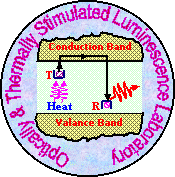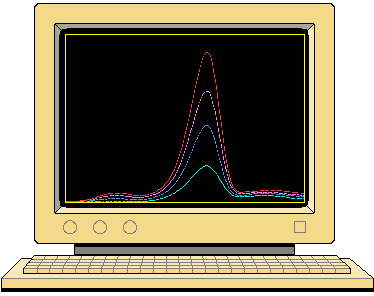
|
|

|
|
Luminescence is a phenomenon exhibited by many crystals, such as diamond, quartz, feldspars and calcite. Energy absorbed from ionizing radiation (alpha, beta, gamma, cosmic rays) frees electrons to move through the crystal lattice and some are trapped at imperfections in the lattice. Subsequent heating of the crystal, or stimulation by absorption of light can release some of these trapped electrons with an associated emission of light - thermoluminescence (TL) or optically stimulated luminescence (OSL) respectively. This is the technology used for dosimetry badges in areas where radiation safety is a concern. The time over which the badge has been exposed is well known, and the total radiation does controls the final luminescence. The badges are heated (TL), luminescence recorded, and total dose derived. Since we know the time period of exposure and total does, we know the average dose per unit time. Now turn the process around; if you know the average dose per unit time, and the total dose from the luminescence, then you know the time period of exposure. This is the fundamental process behind luminescence dating (TL and OSL), as well as electron spin resonance (ESR) dating, which uses a different technique to achieve the same result. To find the age of the sample in years1. type in the total accumulated radiation dose of the sample (in Grays or Gy) 2. type in the annual radiation dose rate (in Grays per 1000 years or Gy/ka) 3. click on Calculate to find the age of the sample OSL and TL dating techniques don't get as much press in the creation/evoluton game, because they cannot be used to measure the billions of years time period characterized by the age of the Earth. But they can be used to measure significant periods nonetheless, especially in the range between about 40,000 to 50,000 years where radiocarbon dating cuts off, and the 1,000,000 years or so required for most radiometric techniques to become reliable. OSL dating is used for dating in the range 100 to 200,000 years and is used where radiocarbon methods are unsuitable. The idea here is that all materials carry extremely low concentrations of radiogenic isotopes, line Uranium, which in turn expose the material to extremely low doses of radiation over a long time. That radiation frees electrons that get trapped in crystal defects, just like dosimetry badges. The total population of trapped electrons in turn determines the total dose. If you know the average dose per unit time, by studying the geology of the site, you can then use the ratio of total dose over average dose, and get the time period. Sunlight on a crystal will evict the trapped electrons much faster than background radiation puts them in. So once the crystal is buried, the "clock" starts. Dig up the crystal, measure its luminescence (either optically or thermally stimulated), and you know the total dose. Compare with the average dose per unit time, and you know how long the crystal has been buried. This is a favorite means for dating buried sediments that are often rich in quartz and feldspar. For other materials, notably non translucent material, electrons become trapped in defects where the lattice potential is too deep and the electrons cannot be stimulated to come out. In those cases, electron spin resonance (ESR), which is much more complicated that luminescence techniques, can be used to count the number of trapped electrons by using a combination of microwaves and a variable magnetic field. The disadvantage of ESR is that it is much more complicated, and has larger uncertainties than luminescence techniques. The advantage of ESR is that, unlike luminescence, the electrons are not evicted from their traps, so the measurement can be repeated as desired on the same sample. One of the key tests of reliability for any dating technique is the ability to intercompare with other techniques; they should all give the same age for the same sample, within the bounds of the usual experimental uncertainties. There is a lot of literature available that demonstrates intercomparison between these luminescence techniques and radiometric dating. The authors performed the following dating measurements, with the indicated resulting ages expressed in thousands of years. Sediments everywhere contain low concentrations of Uranium, Thorium and Potassium which produce a constant stream of ionising radiation. Because this ionising radiation is absorbed and stored by surrounding sediments it can be used for dating the sediment (and the objects in it). With stimulation this stored dose can be made to produce luminescence. The amount of luminescence is proportional to the accumulated dose and the age of the sample can be determined by comparing that dose to the annual radiation dose.
During the event to be dated, for example when sediment transport occurs, individual crystals are exposed to natural daylight and the trapped charge that accumulated during burial is removed (i.e. the light ‘frees’ the trapped electron population, as described above) - termed ‘re-setting’, ‘zeroing’ or ‘bleaching’ of the signal. On subsequent deposition and burial the crystal grains are once again returned to darkness and trapped charge accumulation proceeds as before. Re-setting of the signal is achieved by heating in the case of pottery. In cases where the duration of dosing (since the last resetting event) is not known, as for dating, estimates can be made from laboratory measurements. The response (the sensitivity) of the sample to radiation dose (i.e. the amount of light observed for a given amount of radiation, usually beta -radiation) must be established. This is termed the ‘dose response curve’ or ‘growth curve’. From this relationship the equivalent (in most cases beta -) radiation exposure required to reproduce the light level observed following the environmental dose can be estimated. This estimation is called the ‘equivalent dose’ (De). The De is therefore an estimate of the total dose absorbed during the last burial period. If the ‘dose rate’ (the amount of radiation per unit time administered during burial) is known, the duration of the dosing period (the burial age) can be calculated using Age (years) = De (Gy) / dose rate (Gy per year). Sample CollectionBecause the signal used in both optical dating and TL is very sensitive to light, the collection of suitable samples must be done by a properly trained specialist and under strictly controlled low light conditions. All three paleodosimetric method also depend on detailed environmental information for correct age calculation. Sediment dating requires specialised sampling procedures in which metal cylinders are driven into the sediment to be dated. Following removal of the sample tube it is desirable to measure the environmental radiation dose rate using a portable gamma spectrometer. No special techniques are involved in the collection of pottery or burnt flint samples although exposure to light and heat should be kept to a minimum. On site measurements of the environmental radiation dose are also desirable, especially in the case of burnt flint dating. When on-site measurement of the environmental radiation dose is not possible, soil samples representative of the deposits (up to a distance of 30cm around the pottery or flint) must be collected. In these circumstances it is highly desirable that these deposits are as uniform as possible and that pottery or flint are not collected from near sediment boundaries (edges of pit or changes in sediment type) or large boulders. ApplicationsIn order for luminescence dating to be successful, sediment samples (for OSL dating) must have been exposed to sunlight immediately prior to deposition, such as would normally be expected to have occurred during transport by either water or wind. Pottery and burnt flint must have been heated to at least 400° C. The pottery and flint samples must be sufficiently large so that, after removal of a 2mm layer from each surface, a fragment whose volume is equivalent to at least 1cm x 2cm x 3cm remains. In addition, as an absolute minimum, it is essential to provide a sample of the soil (at least 50g) in which the pottery or flint was buried (see Sample Collection for further details). The typical age range for luminescence dating is ca.10 years to 300,000 years (though this is highly sample dependent). The uncertainty on luminescence dates is typically in the range of ± 5% to ± 12% of the sample age. Luminescence dating is particularly useful when radiocarbon dating is not possible. This would be the case, for example, when organic material has not been preserved or when the relationship between the organic material and the archaeological context cannot be confidently assumed. Further, luminescence dating may also be of help when the age of the sample is greater than the 40-50,000 year limit of radiocarbon dating. |